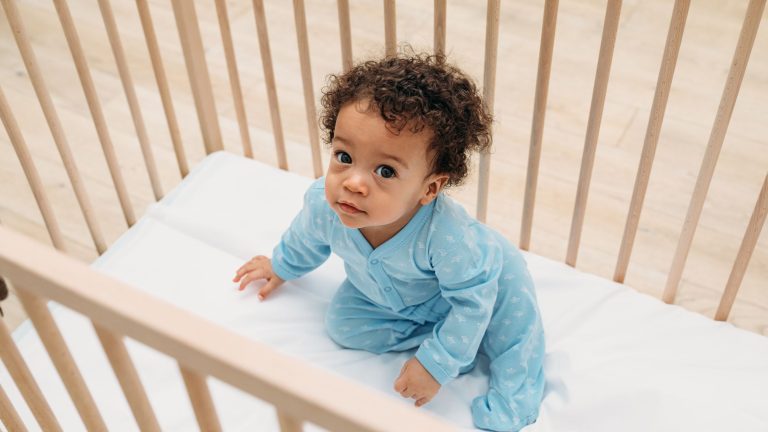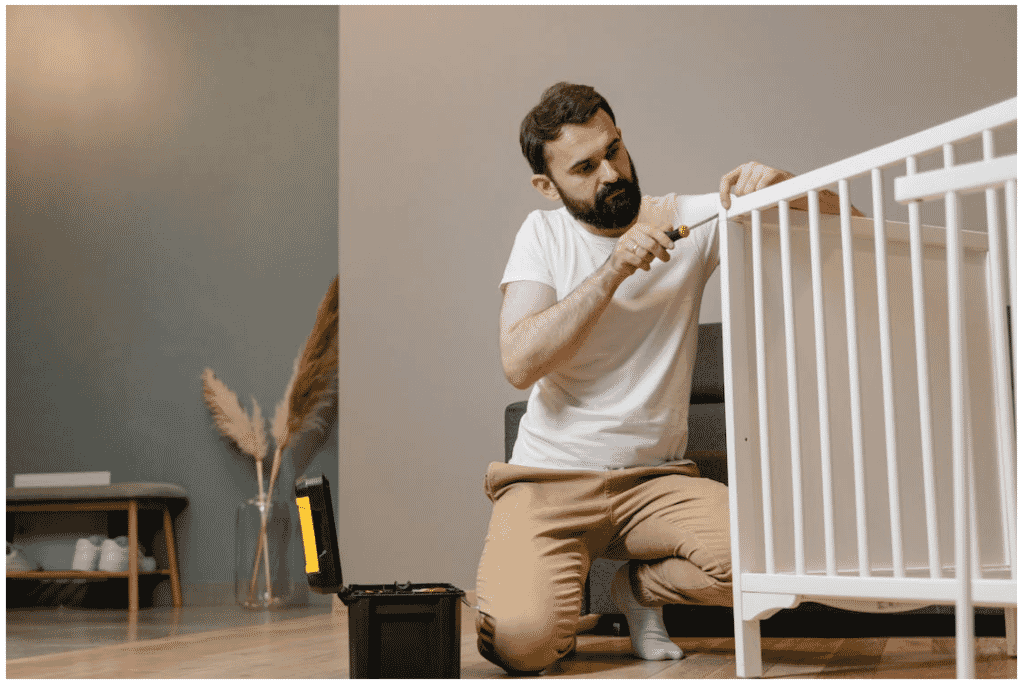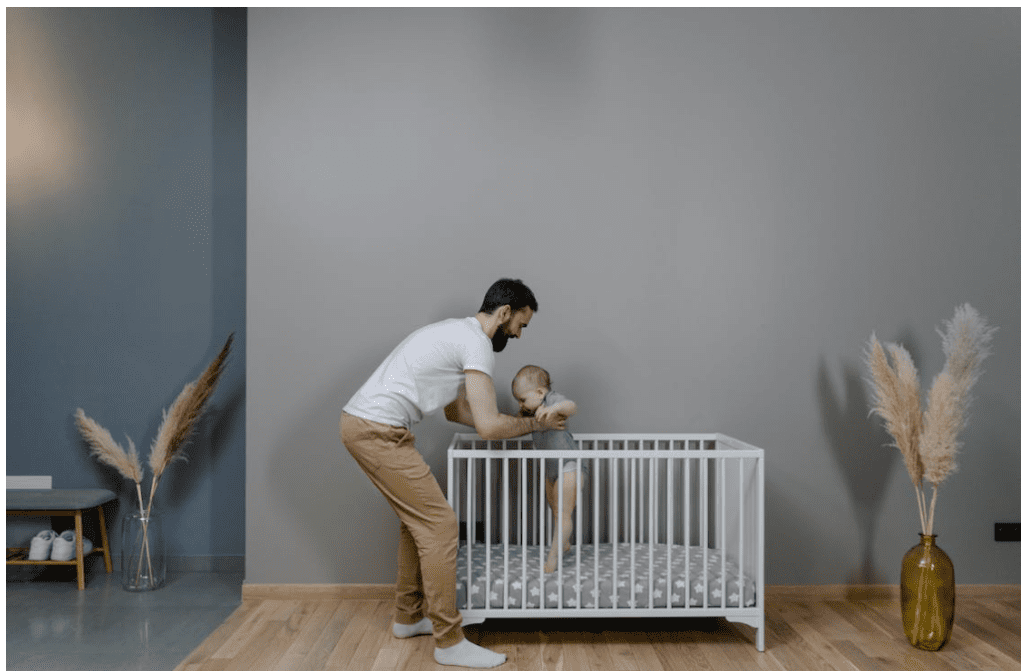
A Guide to Crib Heights – When to Lower Baby’s Crib Mattress
- Created:
11. 4. 2023 - Updated:
11. 6. 2024
Now:
One of the key determinants of your baby’s safety in a crib is the mattress height.
That’s why most cribs have multiple mattress levels that you adjust as the baby grows.
But:
When and how do you lower your baby’s crib mattress? That’s what this article is about.
I will go through the common crib’s mattress levels according to age and milestones.
Why Does The Mattress Height Of A Crib Matter?
Now:
Among all baby sleep products, cribs are regarded as one of the safest. It’s the only sleeping product where it’s safe to leave the baby unattended when they are sleeping.
However, they have the risk of the baby falling out if the mattress height is not set properly.
Cribs account for the majority of injuries emanating from baby sleeping products. This is according to a 2011 study by the American Academy of Pediatrics (AAP)
The 19-year-long study (1990–2008) reported that crib injuries accounted for 83.2% of the total 9,511 annual injury cases.
That’s a huge concern considering they are considered the most stable infant sleep product.
It’s worth noting that most crib injuries occur from falling out of the crib.
And that is where crib height or mattress levels come in.
To avoid these injuries, parents and caregivers are encouraged to adjust the crib mattress height depending on the baby’s age and milestones.
For instance:
While a high mattress setting is dangerous for older babies, it’s safe for an immobile baby during the first few months.
Let’s now discuss the common mattress settings that you will find on most cribs.

Common Crib Mattress Height Settings
| Mattress Height | Age | Info |
|---|---|---|
| The Highest Setting | 0-5 months | This is the highest mattress heightIt’s recommended for use from birth to around 5 months. |
| The Middle Setting | 5-8 months | A crib may have one or more middle settings.The middle setting is ideal when the baby starts making some movements.(Not safe for a baby who is standing on their own) |
| The Lowest Setting | From 9 months | This is the recommended mattress height for a baby who is standing on their own |
| Mattress on The Floor | From 18 months | This is only available for cribs that convert into a floor bed |
Now:
Before we get into the different crib mattress heights or crib settings, let’s start with the definition of a crib height setting or mattress height setting.
Crib settings refer to the height/distance of the crib’s mattress from the floor. Most cribs have 3 crib settings, but there are a few with up to 5 settings.
This lets you either lower or raise the mattress height.
How do you do it?
Now:
All cribs have a removable mattress support. This is usually a spring or wooden support that you attach using bolts on the four ends of the crib.
The crib will have multiple sets of holes, which are the mattress height settings.
To change from one mattress setting to another, remove the mattress support and lower it to your preferred level.
1. The Highest Crib Setting
The top crib setting refers to the first mattress setting from the top, or the highest from the floor.
This is the recommended mattress setting for use from birth to 5 months. However, it is the least used since most parents opt to use a bassinet up to the fifth month.
For those parents who use the crib from birth, this is the ideal mattress height.
Since the baby is immobile during the first few months, this mattress level is safe despite the small height from the top of the rails.
The highest setting also makes it easy for the parent to place and pick up the baby since there is very minimal bending.
Most parents have a hard time bending immediately after delivering.
When Do You Lower To The Middle Setting?
Since the highest mattress has the shortest distance to the top, it’s the most dangerous for a mobile baby.
When should I lower the mattress to the middle level?
Here is how to know when it’s time to go lower
- When the baby shows signs of sitting up on their own
- The moment the baby starts rolling
- When the baby starts crawling
- After 5 months
- If you feel and think it’s time to go lower
Note:
The highest mattress setting must be at least 26 inches from the top, including the mattress height.
Since a crib mattress is supposed to be 6 inches thick, the highest setting should be at least 20 inches from the top of the crib to the top of the mattress.
2. The Middle Crib Setting
The middle mattress setting is the right setting if you are transitioning from a bassinet.
This level is safe for babies who have started crawling, sitting, and rolling over.
While some babies attain some of these milestones as early as 3 months, most babies attain them anywhere between 5 and 8 months.
Now:
Some cribs have more than one middle setting. That is why some cribs have 4 or 5 mattress settings.
The decision on what middle setting to use depends on the parents.
For instance, if the baby has reached only one milestone, you can use the top-middle setting.
However, if the baby has attained most of these milestones, using the lowest-middle setting is safest.
Remember, the lower you go, the harder it gets to put and pick the baby up from the crib.
When Do You Lower To The Lowest Setting?
The right time to lower the mattress to the lowest level is the moment the baby shows signs of standing up.
3. The Lowest Crib Setting
The bottom crib setting is closest to the floor. This is the safest mattress position for a baby who is showing signs of standing.
As with all other settings, don’t wait until the child reaches the milestone. Look for signs that the baby is about to stand, such as the baby pulling up to standing with support.
For some babies, this can be around the 8th month, while for others it can be as late as 12 months.
When the baby is standing up in the crib, it’s easier to reach the top of the crib rails. The lowest mattress position lowers the chances of the baby climbing out of the crib.
When Do You Stop Using The Lowest Setting?
Crib regulations warn that children must stop using a crib when they are taller than 35 inches (2.91 feet).
The study looked at 144 children between the ages of 12.5 and 36.5 months and found that most of them were able to climb out of a crib with a less than 26-inch side rail height.

A Guide On How To Lower A Crib Mattress
Now:
If you have determined it is time to lower the crib mattress, here is how to do it.
Every crib with multiple mattress levels has details on how to do it safely. Most cribs also come with the accessories needed to raise or lower the mattress support.
Here is a general guideline on how to do it, but make sure to consult your crib’s manual.
Step #1 – Empty The Crib
Remove all the bedding from the crib, including the mattress. Then assess the number of mattress levels you have.
For most cribs, you will only have the highest, middle, and lowest.
When the crib is empty, it’s time to move on to the next step.
Step #2 – Get The Right Tools
Get the right tool, which will mostly be either an Allen key or a small spanner. Check if you were supplied with assembly tools.
Step #3 – Topple The Crib
Now:
If your crib has removable side panels, this step is very helpful. However, it does not apply to cribs with fixed side panels.
The idea is to topple the crib and remove the front rail. This way, you will have more room and a better position to access the corner screws.
This also makes removing and setting the mattress support easier in the new position.
After removing the front rail, now remove the mattress support and lower it to the right position.
Remove all four screws on each corner that are holding the mattress support. Make sure you do not lose any of these screws.
After removing the four screws, remove the mattress support. Move it to the next level and screw back the four screws.
Finally, put back the side rail.
Step #5 – Test The Crib
Finally:
Test if the crib is safe and stable by placing a heavy object on it or pressing it down. Also, countercheck all the screws to make sure they are secure.
Improper crib installation is dangerous and risks your baby’s life and health.
Do All Cribs Have Adjustable Mattress Heights?
Yes, almost all baby cribs have adjustable mattress heights. However, there are a few cribs that have a single mattress height.
Single-mattress level cribs are usually inexpensive and will only have the lowest mattress level. This means you will have to strain a lot when placing or picking up the baby from the crib during the first few days.
On the upper end, there are premium cribs with up to five mattress heights. However, be careful when selecting the mattress level. When there are multiple top, middle, or low settings, go with the lowest in each category.
Elevating or Angling the Crib Mattress
Now:
This is a contentious topic.
A common piece of advice that you will see on most forums is that tilting a crib’s mattress helps with congestion and gastroesophageal reflux(GERD).
That’s why there are several products, such as wedges and sleep positioners, that are marketed for inclining a crib mattress.
There is also the DIY hack of placing something like a blanket below the crib mattress to incline it at the head position.
This advice is also sometimes given by pediatricians to kids with reflux.
However, the American Academy of Pediatrics (AAP) says inclining a crib’s mattress is dangerous and doesn’t help with reflux.
Why?
Placing a baby on an inclined surface increases the risk of the baby rolling to the foot of the crib, which can cause breathing problems.
Before you consider inclining the crib mattress, please consult your pediatrician.
Caution
Don’t try tilting the mattress support. That’s why there is no crib that has this functionality.
Also, don’t tilt the crib by either removing the wheels on one side or placing objects on the top legs to raise the front of the wheels.
Doing this is endangering the life of your little one.
Is It Safe To Lower A Crib Mattress To The Floor?
No, unless the crib is designed to be converted into a floor crib, putting a crib mattress on the floor is not safe.
Why?
Cribs have a floor clearance distance that ranges between 6 inches and 15 inches.
That means if you lower the mattress to the floor, there will be some open space between the mattress and the bottom of the rails.
This space is a danger since the child can get trapped between the mattress and the bottom of the crib.
The only time it’s safe to convert a crib into a floor crib is if the crib allows for that design. There are also a few cribs that allow you to remove one side rail so that it can be used as a toddler bed.
However, don’t convert a standard crib into a toddler bed since it will be structurally unstable.
Is it safe to place a crib mattress on the floor?
Yes, despite a crib’s mattress being quite thin (6 inches), it can be used on the floor.
In fact, the AAP recommends placing the mattress on the floor when the baby outgrows the crib and you have not acquired a toddler bed yet.

How To Put Baby In Lowered Crib
Now:
Placing and picking up a baby from a crib is strenuous, especially for mothers who have just delivered and those with back problems.
That’s why the highest mattress setting on cribs is a lifesaver for most parents.
When the mattress level is lowered to the middle or the lowest levels, it becomes even harder to place and pick up the baby.
This is not only a major challenge for those with back problems but also for short parents. Drop-side cribs seemed to address this issue, but they were banned in 2011.
Here are a few tips on how to put a baby in a lowered crib for short parents, disabled parents, and parents with back problems.
- Use a step stool
- Cut the crib’s legs
- Put the baby down awake
- Let the taller partner do it
- Get on your tip toes
- Get a Montessori bed
How To Stop Your Toddler Climbing Out of the Crib
Apart from ensuring that you have selected the right mattress level, you can do a few more things to keep the toddler in the crib.
- Lower the mattress to the floor if the crib has that function
- Use a swaddle or a sleep sack to contain the baby
- Turn the crib around if there is a slightly higher side
- Switch to a toddler bed
- Encourage your child to call you if they want to move out
- Buy the movement restricting pajamas
- Have a baby monitor
At What Age Do You Transition From Crib To A Toddler Bed?
Now:
There is no specific age when you should stop using a crib, but it’s between 18 months and 36 months for most babies.
The right time is when the baby outgrows it, and this differs from one baby to another.
According to the CPSC, a child should stop using a full-size baby crib when they reach 35 inches in height.
However, a child should stop using the crib earlier if they are able to climb out. This is even if they haven’t hit the height limit.
Other signs that the baby should transition to a toddler include
- When the baby expresses interest in sleeping in a toddler’s bed
- If the baby is potty trained to allow them to visit the bathroom on their own
- When their chest or nipples are above the top of the side rails
- If the child does not fit in the crib or when there is very little space left
Final Tip: Annie Baby Monitor – Your Watchful Companion in the Nursery
Watching over your little one when they start sleeping on their own is important.
You can easily do that by placing a monitor in their nursery. With Annie’s real-time video and audio monitoring, as well as cry and motion detection, you can always stay connected with your child, which will give you peace of mind and give you peace of mind.

Looking for a top-notch baby monitor? Look no further than Annie Baby Monitor. It’s the perfect solution for keeping tabs on your little one. Check it out now.
Frequently Asked Questions on Crib Heights
The standard height of a crib ranges between 30 and 47 inches.
The CDC advises that a child should stop using a crib when they reach 35 inches in height. Of course, the baby should stop using it earlier if there are other transition signs, such as being able to climb out of the crib.
Mattress height should be lowered from the highest crib setting to the middle setting when:
– The baby can sit
– The baby start pulling on their hand
– According to manufacturers’ recommendations
When the baby shows signs of standing, the mattress level should be lowered to the lowest level.






